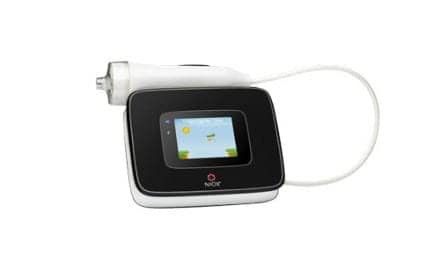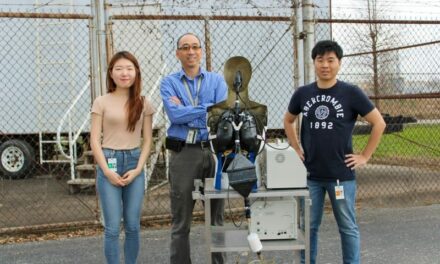NPPV has been shown to significantly prolong survival and improve quality of life of ALS patients with chronic ventilatory failure.
Bilevel noninvasive positive pressure ventilation (NPPV) has been successfully used to support patients with acute, as well as chronic, ventilatory failure.1,2 The neuromuscular-disease patient population with progressive restrictive pulmonary disease has, perhaps, benefited most from the development of noninvasive ventilatory support. In spite of this fact, many amyotrophic lateral sclerosis (ALS) patients are never informed of the option to consider NPPV as a means of ventilatory support. Instead, they are informed only of the long-term option of volume ventilation via tracheostomy. NPPV has, nonetheless, been shown to prolong survival significantly and to improve quality of life for ALS patients with chronic ventilatory failure.3,4,5
ALS is a disease of unknown cause that affects both the anterior horn cells and parts of the spinal cord. About 10% of cases constitute an inherited autosomal-dominant disorder. The other 90% occur randomly. This disease affects approximately one in 1,300 people.6 ALS usually manifests itself when the patient reaches middle age, but it may begin before age 20. Its onset is usually associated with either of two distinct presenting symptoms. When muscle cramps and weakness occur in a limb or multiple limbs, the disease is called skeletal-muscle–onset ALS. When it begins in the muscles above the neck and affects speech and swallowing, it is called bulbar ALS because the bulbar nerves serve the affected throat muscles. Patients may have a predominantly skeletal or bulbar presentation, but most will have some combination of both sets of symptoms as the disease progresses.
ALS threatens a patient’s life only through respiratory complications.6 The onset and progression of ventilatory muscle weakness are highly variable. Patients may have significant bulbar involvement, with dysphagia and difficulty in speaking, without experiencing significant ventilatory compromise until much later in the disease’s course. Others may initially present with good ventilatory function and then experience a rapid decline in ventilatory muscle strength within months, without significant bulbar involvement.
At some point in the course of ALS, however, the patient’s ventilatory muscle strength will start to decline progressively, leading to chronic ventilatory failure. Weakening of the inspiratory and expiratory muscles compromises the patient’s ability to cough and clear pulmonary secretions. Acute respiratory failure usually results from an upper-respiratory infection that develops into pneumonia. Patients who present with early bulbar symptoms develop dysphagia and chronic aspiration of oral secretions. This chronic risk of aspiration pneumonia can greatly increase the potential for acute respiratory failure to occur long before the patient experiences significant ventilatory compromise.
Many ALS patients are not well informed concerning how the progressive neuromuscular deterioration of this disease will affect their breathing and threaten their lives. They must be fully informed of how chronic, progressive respiratory failure develops in ALS and of how the resulting decreased ability to cough and clear pulmonary secretions places them at risk for pneumonia and acute respiratory failure. The patient and family must also be completely informed about the respiratory course of ALS relative to the onset of either bulbar or skeletal-muscle dysfunction. They should then be introduced to the various means of ventilatory support, starting with NPPV and progressing to tracheostomy and volume ventilation. Some neuromuscular-disorder clinics have developed comprehensive, stepwise programs that allow the patient and family to be fully informed and to make informed decisions early (before an acute respiratory event dictates the course of care for lack of informed consent).
ALS patients should be seen quarterly for serial assessment of their pulmonary functions in order to determine their rates of decline in ventilatory muscle strength. Pulmonary function tests should include determinations of vital capacity (VC), maximum inspiratory pressure (MIP), and peak expiratory flow cough (PEFC). The accuracy of pulmonary function testing in this patient population often depends on patients’ oral muscular dysfunction. Bulbar-onset ALS patients who can no longer maintain a sufficient mouth seal using a conventional flange-type mouthpiece should be tested using either a face mask or an oral mouth seal. VC and MIP values will provide an indication of the rate of decline in ventilatory muscle weakness. PEFC testing is an established means of determining the neuromuscular-disease patient’s ability to clear pulmonary secretions. This test is performed using a conventional peak flow meter with an appropriate mouth seal. Patients who can no longer generate a peak flow of >180 L/min are at significant risk for respiratory failure in the event of pneumonia.7
Patients presenting with significant bulbar dysfunction have increased difficulty coughing due to weakened glottic control. The weakened muscles that control the opening of the glottis partially occlude the airway, decreasing the flow of exhaled air during a cough. This can compromise the patient’s ability to clear pulmonary secretions well before ventilatory muscle strength has been severely affected. The ability to cough and clear secretions can be augmented by hyperinflating the patient using a resuscitator bag with a face mask or mouthpiece and then using quad coughing maneuvers.8 An insufflation-exsufflation cough-assistance device has also been shown to provide an effective means of airway clearance in neuromuscular-disease patients with weak coughing ability.9 Unfortunately, it has not been effective in ALS patients with significant bulbar symptoms because of their poor glottic control.
Pulmonary Function Testing
When serial pulmonary function testing begins, patients will almost always ask the pulmonologist to provide them with some indication of how long they can expect to live before their weakened ventilatory status becomes life-threatening. This is usually difficult to determine, however, due to the variability of progression in ALS. Serial pulmonary function tests are primarily used to determine when to initiate NPPV or volume ventilation. Patients should also be questioned regarding the presence of hypercarbic symptoms (including morning headaches, vivid nightmares, night sweats, nocturia, daytime drowsiness, and falling asleep frequently during the day). The American College of Chest Physicians’ 1999 consensus conference guidelines10 for starting NPPV in patients with restrictive pulmonary disease specify the presence of the symptoms of hypercarbia and that the patient must meet one physiologic criterion:
• PaCO2 of more than 45 mm Hg;
• oxygen saturation of less than 88% for 5 consecutive minutes, as measured using nocturnal oximetry; or
• for progressive neuromuscular disease, MIP of less than 60 cm H2O or forced vital capacity of less than 50% of the predicted value.
NPPV has been shown to prolong the survival of skeletal-muscle–onset ALS patients significantly, providing improved quality of life compared with that of patients who either elect not to use any type of ventilatory support or are never informed about NPPV.11 Bulbar-onset ALS patients do not receive the same degree of benefit. Their inability to control oral secretions and difficulty in maintaining a sufficient mouth seal cause them to be intolerant of nasal-mask ventilation. The increased airflow associated with NPPV can also greatly increase the already significant potential for aspiration in these patients. Bulbar ALS patients who start NPPV use early (in relation to the progression of bulbar symptoms) may be better able to acclimate to NPPV than those patients who do not start using it until their ventilatory status reaches the level defined in the American College of Chest Physicians guidelines. On the other hand, ALS patients who start to use NPPV before they have significant ventilatory compromise may not be motivated to continue with the therapy if there is no perceived symptomatic relief. Introducing the patient to NPPV via nasal mask through a short trial in the outpatient clinic setting, long before there is an actual need to start therapy, can be very beneficial in helping the patient understand what the therapy involves.
When test results indicate that NPPV therapy should be started, the patient should be scheduled for a clinic visit that allows enough time to instruct the patient and family fully about NPPV. The initial comfort and fit of the nasal mask are critical to the patient’s acceptance of this therapy. Mouth-seal masks and full-face masks are also available, but are rarely used for the neuromuscular-disease patient because of the potential for aspiration in the event of gastric reflux (and because of the patient’s inability to remove the mask easily). The patient should be shown, and should have the opportunity to try, a variety of nasal masks during the clinic visit in order to determine which type is most comfortable. Many patients have some degree of claustrophobia, and they do not tolerate conventional nasal masks with forehead bridges that partially block their vision. These patients are generally more comfortable with lower-profile nasal masks or with smaller masks having minimal strapping over the field of vision.
Patients Often Reluctant
After patients have been fitted with masks and headgear with which they feel comfortable, they can then begin to use NPPV. Patients are often reluctant to start this therapy when they sense the initial airflow level. Minimal initial bilevel settings of 7 to 8 cm H2O for inspiratory positive airway pressure (IPAP) and 3 to 4 cm H2O for expiratory positive airway pressure (EPAP) will help the patient tolerate introduction to NPPV. Gently placing the mask over the patient’s nose without attaching the headgear, while reassuring the patient that the ventilator is only responding to breathing efforts and helping him or her take larger breaths, can assist in overcoming much apprehension. Some patients who are uncomfortable may need to start with even lower inspiratory pressures.
If the patient is reasonably comfortable with the initial pressure levels, the headgear can be put in place and IPAP titration can begin. IPAP can be increased while estimated tidal volume and chest excursion are monitored. Estimated tidal volumes of approximately 500 mL are adequate for the initiation of therapy. The patient’s initial comfort with the therapy is more important than a specific breath volume. The neuromusclar-disease patient’s need for augmented breath volume is best achieved using wide-span bilevel NPPV.9 This span is set by increasing IPAP while maintaining minimal EPAP settings. The patient will generally feel uncomfortable breathing against increased EPAP, given the ventilatory muscle weakness involved. Increased EPAP is usually employed only when a neuromuscular-disease patient has documented obstructive sleep apnea and pressure titration has been performed in a sleep laboratory.12 Another exception is made for the neuromuscular-disease patient who has an obstructive or restrictive pulmonary comorbidity that may call for supplemental oxygen use; increased EPAP will then be needed to maintain adequate oxygenation and ventilation.
NPPV ventilators should be set for the spontaneous/timed mode at a base rate of 12 to 14 breaths per minute to ensure that the patient will receive an adequate number of breaths during sleep. Neuromuscular-disease patients with chronic ventilatory failure may not always produce sufficient inspiratory effort to start the ventilator’s inspiratory pressure cycle during sleep, especially during the period of rapid eye movement. As the ALS patient’s ventilatory muscle weakness progresses, the inspiratory pressure must be titrated to maintain adequate ventilatory support. Titration can be done based on the relief of recurrent symptoms of hypercarbia, on nocturnal oximetry results, or on arterial blood gas levels.
The need for ventilatory support will progress from primarily nocturnal use to increasing daytime use until the patient is supported 24 hours per day. NPPV systems can be adapted for portability using a gel-cell battery and power inverter on a wheelchair. NPPV systems consume three to eight times more power than volume ventilators, depending on the inspiratory pressure setting, and will have a limited duration of use (unless the patient has a powered wheelchair with a redundant battery supply).
NPPV support’s applicability is limited by the MIP settings of the ventilator. The effectiveness of NPPV may also be limited by the patient’s tolerance of increasing inspiratory pressures or by the development of gastric insufflation and distension. The alternating use of different masks and the application of gel-dressing patches to sensitive nasal areas can help to prevent or minimize this problem. The development of nasal congestion can also affect the patient’s ability to tolerate this therapy. The addition of a cool or heated humidifier to the breathing circuit may be enough to relieve congestion. Other alternatives include nasal drying agents, nasal steroids, or decongestants (if the patient does not have significant hypertension).
Many patients who use NPPV lose the benefit of ventilation as their mouths open during sleep. Bulbar-onset ALS patients will almost always need some type of chin strap to aid in maintaining a sufficient mouth seal for adequate ventilation. Some patients who cannot tolerate chin straps find that a soft cervical collar will support the chin without causing discomfort. As ALS patients lose the ability to adjust or remove the mask interface, they will often feel more vulnerable and uncomfortable with this lack of control. It is important to encourage continued contact with the patient and family so that any management concerns that arise can be addressed promptly.
Opportunities for Procedures
Those ALS patients who are acclimated to NPPV may have a wider window of opportunity for elective procedures requiring some degree of sedation. The current evidence-based practice parameters of the American Academy of Neurology13 (AAN) indicate that ALS patients should undergo percutaneous endoscopic gastrostomy (PEG) procedures before their VC levels are less than 50% of the predicted value. This recommendation is based on a significant history of morbidity and mortality in ALS patients with VC levels of less than 50% of the predicted value who underwent PEG procedures with ventilatory support via endotracheal intubation. PEG procedures have, however, been performed without complication in five ALS patients with VC levels of 21% to 44% of the predicted value using NPPV and conscious sedation.14
In the past, ALS patients might not have been informed that NPPV was an option for ventilatory support, either because the physician was not aware of NPPV or because the physician did not believe that the patient would obtain improved quality of life and longer survival through its use. This prejudgment of the neuromuscular-disease patient’s quality of life and the withholding of information concerning ventilatory support alternatives are well documented.15,16 Fortunately, the 1999 evidence-based practice guidelines12 developed by an AAN consensus committee devote a significant portion to the respiratory management of ALS patients. In the guidelines, NPPV has been validated as a clinically proven means of maintaining adequate ventilatory support, extending patient survival, and maintaining quality of life for ALS patients. The patients who use NPPV are also generally better able to make decisions concerning the continuance of long-term volume ventilation, whether noninvasive or delivered via tracheostomy.17
As RCPs, we need to play a very large role in diagnostic screening, as well as in the initiation and management of ventilatory support for the neuromuscular-disease patient population.
Louis J. Boitano, MS, RRT, RPFT, is a staff RCP, in the Pulmonary Clinic, at the University of Washington Medical Center, Seattle.
References
1. Hill NS. Noninvasive ventilation. Am Rev Respir Dis. 1993;147:1050-1055.
2. Abou-Shala N, Meduri GU. Noninvasive mechanical ventilation in patients with acute respiratory failure. Crit Care Med. 1996;24:705-715.
3. Piper AJ, Sullivan CE. Effects of long term nocturnal nasal ventilation on spontaneous breathing during sleep in neuromuscular and chest wall disorders. Eur Respir J. 1996;9:1515-1522.
4. Aboussouan LS, Khan SU, Meeker DP, Stelmach K, Mitsumoto H. Effect of noninvasive positive pressure ventilation on survival in amyotrophic lateral sclerosis. Ann Intern Med. 1997;127:450-453.
5. Pinto AC, Evangelista T, Carvalho M, Alves MA, Sales Luis ML. Respiratory assistance with a non-invasive ventilator (Bipap) in MND/ALS patients: survival rates in controlled trials. J Neurol Sci. 1995;129:S19-S26.
6. Bach JR. Guide to the Evaluation and Management of Neuromuscular Disease: The Natural Histories. Philadelphia: Hanley & Belfus Inc; 1999.
7. Leith DE. Lung biology in health and disease: respiratory defense mechanisms, part 2. In: Brain JD, Proctor D, Reid L, eds. Cough. New York: Marcel Dekker; 1977:545-592.
8. Bach JR. Guide to the Evaluation and Management of Neuromuscular Disease: Noninvasive Ventilation. Philadelphia: Hanley & Belfus Inc; 1999.
9. Bach JR. Mechanical insufflation-exsufflation: comparison of peak expiratory flows with manually assisted and unassisted coughing techniques. Chest. 1992;104:1553-1562.
10. Goldberg A, Leger P, Hill N, et al. Clinical indications for noninvasive positive pressure ventilation in chronic respiratory failure due to restrictive lung disease, COPD, and nocturnal hypoventilation—-a consensus conference report. Chest. 1999;116:521-534.
11. Bach JR. Guide to the Evaluation and Management of Neuromuscular Disease: Ethical Considerations. Philadelphia: Hanley & Belfus Inc; 1999.
12. Bach JR. Pulmonary Rehabilitation, the Obstructive and Paralytic Conditions: Conventional Approaches to Managing Neuromuscular Ventilatory Failure. Philadelphia: Hanley & Belfus; 1996.
13. Miller RG, Rosenberg JA, Gelinas DF, et al. Practice parameter: the care of the patient with amyotrophic lateral sclerosis (an evidence-based review). Report of the Quality Standards Subcommittee of the American Academy of Neurology. Neurology. 1999;52:1311-1323.
14. Boitano LJ, Jordan T, Benditt JO. Noninvasive positive pressure ventilation during percutaneous gastrostomy placement in amyotrophic lateral sclerosis. Respiratory Care. 1999;44:1219. Abstract.
15. Bach JR. A comparison of long-term ventilatory support alternatives from the perspective of the patient and the caregiver. Chest. 1993;104:1702-1706.
16. Bach JR. Ventilator use by Muscular Dystrophy Association patients: an update. Arch Phys Med Rehabil. 1992;73:179-183.
17. Oppenheimer EA. Respiratory management and home mechanical ventilation in amyotrophic lateral sclerosis. In: Mitsumoto H, Norris FH, eds. Amyotrophic Lateral Sclerosis: A Comprehensive Guide to Management. New York: Demos, 1994.









